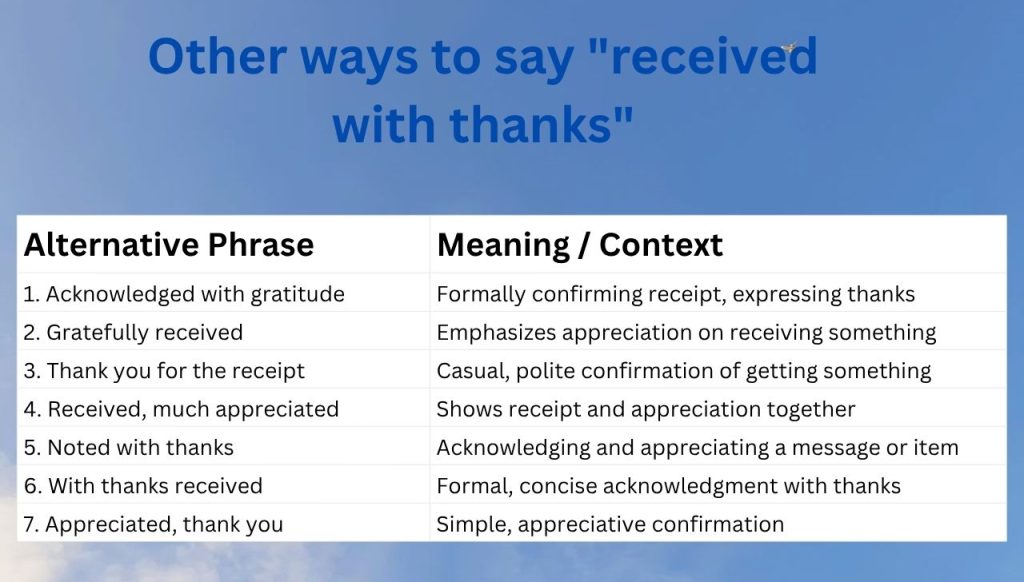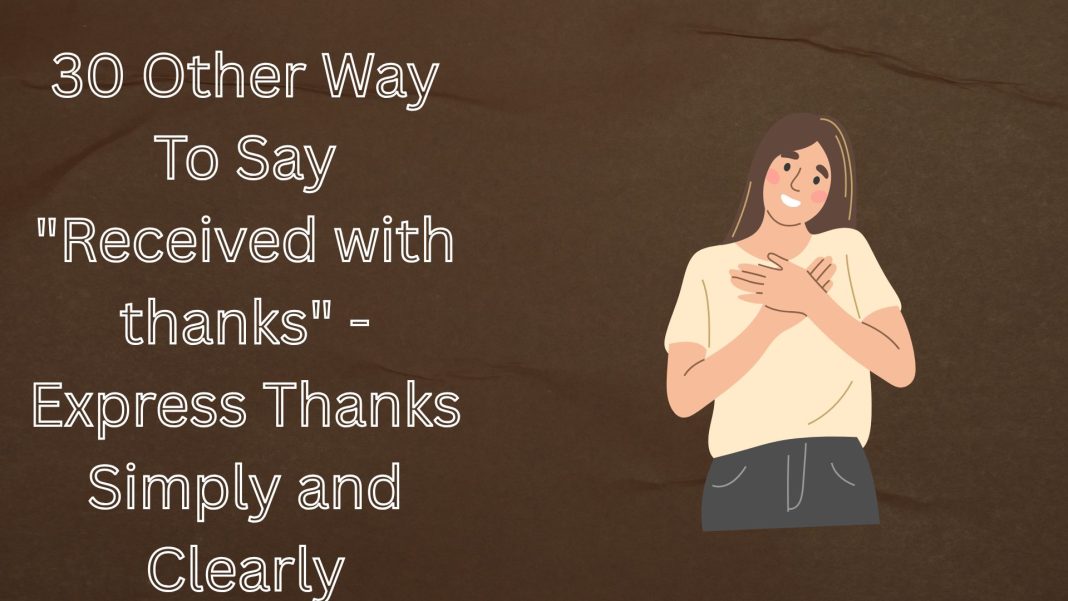When someone sends you something—a document, payment, or gift—responding with “Received with thanks” is a polite way to acknowledge it. But honestly, it can get a bit repetitive and plain over time. Luckily, there are plenty of other ways to say it that feel fresh, clear, and just as courteous. Whether you want to sound more professional, casual, or simply mix things up, knowing a few alternatives can make your communication stand out. Let me explain why switching up your phrases not only keeps conversations lively but also shows genuine appreciation in different tones and settings.
“Received with thanks” Meaning
“Received with thanks” is a simple, polite way to acknowledge that you’ve gotten something—usually a document, payment, package, or message—and you’re expressing appreciation for it. Think of it as a little courteous nod that says, “Hey, I got what you sent, and thanks for that.”
This phrase is often seen in emails, invoices, or formal letters. It’s a neat, professional way to confirm receipt without needing to say much else. Kind of like when someone hands you a gift, and you say, “Thanks!”—but in writing.
When to use “received with thanks”
“Received with thanks” is a polite phrase used chiefly in written communication to acknowledge that you have received something—like a document, payment, or information—and to express your gratitude. It’s a neat way to confirm receipt while showing appreciation, especially in business emails or formal messages. Instead of a simple “Got it,” this phrase adds a touch of professionalism without sounding overly stiff or complicated.
You’ll typically use “received with thanks” to keep your message clear and courteous, particularly in formal or informal contexts. It works best as a brief acknowledgment, like “Invoice received with thanks.” If you want to soften it or keep the conversation going, add a friendly follow-up, such as “Received with thanks. I’ll review it and get back to you shortly.” It’s a small phrase that helps maintain smooth, respectful communication.
Why to say “received with thanks”
Saying “received with thanks” is a simple, polite way to confirm you got something—like a document, payment, or information—while also showing appreciation. It’s a neat, efficient phrase that lets the sender know their message arrived safely and that you acknowledge their effort. This clarity helps avoid confusion and keeps communication smooth in professional settings. Adding “thanks” keeps the tone friendly and cooperative, even in brief exchanges.
While it might sound formal or old-school, “received with thanks” still works perfectly in business emails or letters where a professional touch is essential. If you want something casual, say “Got it, thanks!” or “Thanks for sending this over.” But when you want to keep things polished and clear, this phrase is a classic way to say, “I got it, and I appreciate it,” all in just three words.

Other ways to say “received with thanks”
| Alternative Phrase | Meaning / Context |
|---|---|
| 1. Acknowledged with gratitude | Formally confirming receipt, expressing thanks |
| 2. Gratefully received | Emphasizes appreciation on receiving something |
| 3. Thank you for the receipt | Casual, polite confirmation of getting something |
| 4. Received, much appreciated | Shows receipt and appreciation together |
| 5. Noted with thanks | Acknowledging and appreciating a message or item |
| 6. With thanks received | Formal, concise acknowledgment with thanks |
| 7. Appreciated, thank you | Simple, appreciative confirmation |
| 8. Thanks for sending | Informal, thanking for the delivery or info |
| 9. Confirmed with thanks | Official confirmation with gratitude |
| 10. Receipt acknowledged | Formal statement that something is received |
| 11. Thank you, duly noted | Polite, showing receipt and understanding |
| 12. Grateful for receipt | Expresses sincere thanks on receipt |
| 13. Thanks for your promptness | Thanks plus acknowledgement of timeliness |
| 14. Received and appreciated | Confirms receipt plus gratitude |
| 15. Acknowledged with thanks | Formal and polite receipt confirmation |
| 16. Appreciated and received | Shows appreciation alongside confirmation |
| 17. Many thanks for receipt | Friendly, warm way to say thanks for receiving |
| 18. Thank you, received safely | Emphasizes safe receipt and gratitude |
| 19. Grateful for your cooperation | Thanks with a hint of teamwork or collaboration |
| 20. Received, thank you kindly | Polite and warm acknowledgment |
| 21. Thank you, item received | Direct and clear, polite confirmation |
| 22. Thanks for the confirmation | Appreciates a reply or verification |
| 23. Received with appreciation | Slightly formal, focusing on gratitude |
| 24. Your message has been received | Neutral, for email or message receipt |
| 25. With gratitude received | Formal, emphasizes heartfelt thanks |
| 26. Noted and thanked | Brief, polite receipt plus thanks |
| 27. Confirmed receipt, thank you | Formal acknowledgment with thanks |
| 28. Thanks for your attention | Polite, often used after receipt and review |
| 29. Acknowledged and appreciated | Formal, showing receipt and gratitude |
| 30. Receipt confirmed with thanks | Polite, official confirmation plus thanks |
Conclusion
So, next time you want to acknowledge something with gratitude, try switching from the usual “Received with thanks.” A simple phrase can set the tone and make your message feel more personal or polished. With these alternatives, you’ll keep your responses clear, warm, and engaging—no matter the situation. After all, saying thanks doesn’t have to be boring; it can be a little moment of connection in your everyday exchanges.

Grammar Nerd, ESL Trainer, Low-Key Comma Crusader
Daniel has taught English for over a decade, from small community classes in Oaxaca to bustling university halls in London. He has a knack for turning even the driest grammar points into relatable, real-life language tools—think fewer red pens, more real talk. He co-founded Grammation to make grammar less gatekeeper-y and more global. When he’s not decoding sentence structures, he’s probably hiking with a paperback novel or adding unnecessary hyphens for fun.
“The rules of grammar should empower people—not trip them up.”


